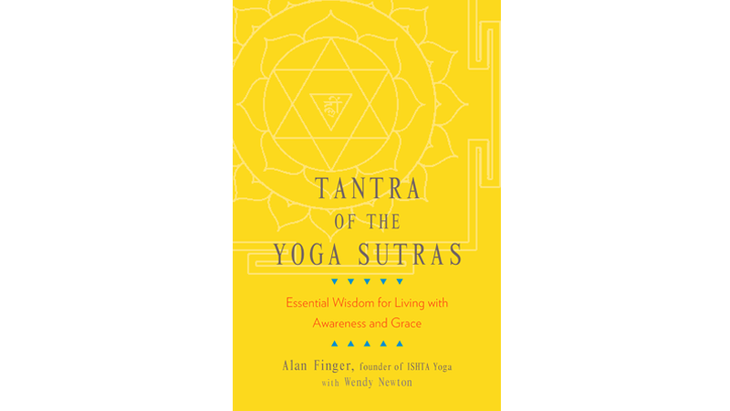Heading out the door? Read this article on the new Outside+ app available now on iOS devices for members! Download the app.
The mind wants things to be linear, definable, and manageable. It understands things in dualistic terms. It wants solutions and a list of steps we can take to arrive at those solutions. But the idea that yoga is a process of spiritual evolution—rather than a linear progression to something that we must find “out there”—is essential to understanding the Yoga Sutras from a Tantric perspective.
See also Tantra Yoga’s Key to Vitality: The 7 Chakras
A Tantric Approach the Yoga Sutras
The eight limbs are both a sequential system and a holistic practice. There is an internal logic to moving from one limb to the next in the given order. The yamas and niyamas help us to approach asana with the proper intention for practice; asana prepares the body for working with the breath; quiet and controlled breath helps us to withdraw the senses, which helps us focus the mind, and so on. But the eight limbs can also be applied as a holistic practice in which all the limbs function simultaneously and synergistically. From this holistic perspective, the practices are done in a way that best suits the needs of the individual in order to evolve spiritually.
The eight limbs are like a road map to samadhi. When you are traveling to a destination, you consult a map and plan a route. But then, when you are actually on the road, you may encounter circumstances such as traffic and detours. You might not immediately know which way to go. So you consult your map for alternative routes and adjust your plan accordingly. The more you know the landscape, the easier it is to move through or avoid the trouble spots.
See also Get to Know the Eight Limbs of Yoga
How you use the map of the eight limbs depends on your karma and where you are in the development of your practice. You might need to spend time going from limb to limb in a prescribed order, because it is not always clear what our karmic circumstances are. Once we have established our practice and developed some perspective, or viveka, we might be able to quickly transcend a trouble spot and apply the limbs in more individualized and nuanced ways. Our unique karmic circumstances dictate where, how, and for how long we need to focus our effort. What yoga practice looks like for each yogi is highly individual and changes over time.
Why Samadhi May Not Be as Far Off as You May Think
From the perspective of the limited mind, samadhi seems like a goal in the future that we will someday arrive at or not. We may succeed at it or we may fail. But if, through the process of yogic evolution and growth, we can move toward the experience of samadhi, that experience itself may show us a very different perspective. Because samadhi is beyond time, thought, and our individual attachment to outcomes, it allows us to regain the big picture that is beyond the reaches of the linear mind. In samadhi, we start to understand that there is no “out there,” and that experience changes our outlook, as it infuses back into how our mind relates to our experiences in life.

The process that the Yoga Sutras describe is one of spiritual evolution and growth. Like the physics of our own universe, it is cyclic, dynamic, and expansive rather than static or linear. In Tantra, one of the most basic teachings is that because we individuals are an integral part of the universe, the intelligence, or consciousness, of the universe is really at the core of who we are. Universal intelligence is our own true nature, and samadhi is that experience. When we tap into the experience of samadhi, it fundamentally affects every moment and aspect of our living, because it aligns us with the greater intelligence of the universe and takes us out of the limited and linear perspective that is the domain of the mind.
See also 5 Ways to Turn a Mental Breakdown into a Spiritual Breakthrough
About Alan Finger
South African Tantric and Kriya Yoga Master Alan Finger began studying yoga at the age of 16 with his father and renowned swamis of the past century. He is the founder and figurehead of ISHTA Yoga. Before creating a home for ISHTA, Alan co-founded Yoga Zone, Be Yoga and Yoga Works. He has co-authored several books including Introduction to Yoga and Chakra Yoga.
About Wendy Newton
Wendy Newton, E-RYT500, C-IAYT, BCPP, is a yoga therapist, teacher trainer, educator and writer. She is co-author, with Alan Finger, of Tantra of the Yoga Sutras, and creator of the Tantra of the Yoga Sutras training program. Learn more about her at wendynewtonyoga.com.
From Tantra of the Yoga Sutras by Alan Finger and Wendy Newton © 2018 Reprinted in arrangement with Shambhala Publications, Inc. Boulder, CO.
Want to explore the chakras through a Tantra and Kriya lens? Join Alan Finger and Sarah Platt-Finger, co-founders of ISHTA Yoga, for YJ’s 4-week online course, Chakras 101: Unleash the Wisdom and Vitality Within. Through lessons, meditations, asana, mantras, and visualizations, you will learn how to balance these whirling forces of subtle energy, from root to crown. You’ll also fill in the blanks and discover what, exactly, chakras are, where they came from, and how they work. The results: The ability to alter your state of mind; carry yourself with more confidence and ease; and tap into your innate intelligence and power. Sign up today!